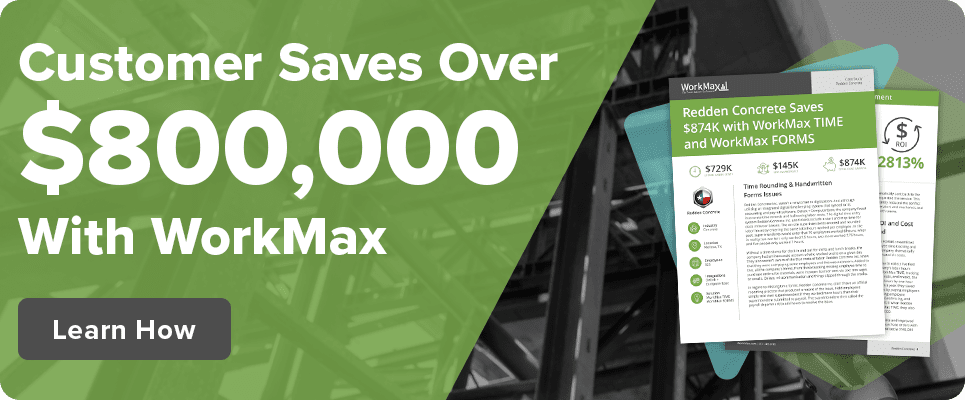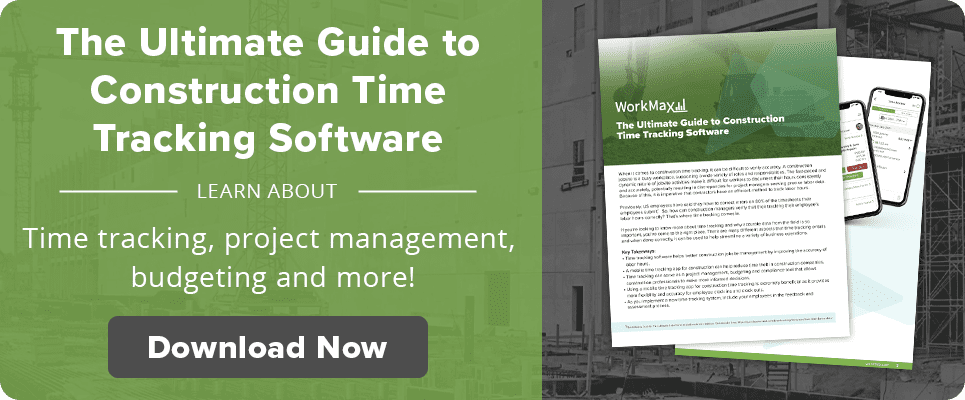Our users reported over 96% customer satisfaction for the last 10 years. Schedule a personal tour of our software to see how we can improve your business’s productivity.
Table of Contents
Share Article
In today’s dynamic workplace, accurate time tracking has evolved far beyond simple punch cards and paper timesheets. Modern businesses rely on sophisticated time tracking solutions like WorkMax to:
- Optimize productivity
- Ensure compliance
- Streamline payroll processes
Whether you’re implementing a new time tracking system or looking to maximize the benefits of your current solution, understanding the terminology is essential.
This comprehensive glossary serves as a guide to navigating the world of time tracking software and applications. These are essential terms every manager, HR professional, and business owner should know.

Use this resource to make more informed decisions about your time tracking processes.
A
Actual Time — The precise amount of time spent on a task, project or at a worksite, as recorded by time tracking systems, contrasted with estimated or scheduled time.
Activity Tracking — The digital monitoring of employee actions performed on company devices to determine productivity levels and time spent on specific tasks.
Attendance Management — The process of tracking and managing employee attendance, including reporting absences, tardiness and time-off requests.
Audit Trail — A chronological record of system activities that captures who performed what action, when it was done and how it affected the data, used to verify compliance with labor laws and company policies.
Automated Time Tracking — A system that records work hours without manual input, often using GPS location, computer activity monitoring or biometric verification.
B
Billable Hours — Work time that can be directly charged to a client, project or task, distinguishing it from non-billable administrative or internal work.
Biometric Authentication — Using unique physical characteristics such as fingerprints, facial recognition or retinal scans to verify employee identity during clock-in and clock-out processes.
Breadcrumbing — The continuous tracking of an employee’s location throughout their workday, creating a digital trail of their movements for verification, safety monitoring and route optimization purposes.
Break Time — A designated period during working hours when employees are not actively engaged in work activities, often mandated by labor laws.
Budget Variance — The difference between estimated labor costs and actual labor costs for a specific project or task.
C
Clock In/Clock Out — The process of recording the start and end times of a work period in a time-tracking system.
Compliance — Adherence to labor laws, regulations and internal policies regarding work hours, overtime, breaks and related employment standards.
Control Center — A centralized dashboard interface that enables administrators to monitor all time-tracking activities across the organization, manage user permissions, configure system settings and generate comprehensive real-time reports.
Cost Code — A unique identifier assigned to specific tasks or phases within a project for accurate time and expense tracking.
Custom Fields — User-defined data fields that can be added to time entries to capture project-specific information beyond standard tracking elements.
D
Dashboard — A visual interface displaying real-time data about employee time allocation, project progress and productivity metrics.
Data Export — The ability to transfer time tracking information to other systems such as payroll, accounting or project management software.
Digital Time Card — An electronic version of a traditional paper timesheet used to record hours worked, often accessible via mobile devices or web browsers.
E
Employee Scheduling — The creation and management of work schedules, including shift assignments, rotation patterns and availability management.
Exception Reporting — Automated notifications that alert managers to unusual time tracking patterns such as missed punches, excessive overtime or unauthorized absences.
F
Face Recognition — A biometric technology that verifies employee identity by analyzing facial features during clock-in procedures.
Flex Fields — Customizable data entry fields within a time tracking system that can be configured to collect specific information relevant to a company’s unique workflow, projects or compliance requirements.
Flex Time — A work arrangement allowing employees to choose their start and end times while still completing required hours, tracked through flexible time tracking systems.
G
Geofence — The actual virtual boundary that defines a specific geographic area used for triggering automated time tracking actions when employees enter or exit designated worksites.
Geotracking — Using GPS technology to verify an employee’s location when they clock in or out, ensuring they are at the designated worksite.
Geofencing — A virtual geographic boundary that triggers time tracking actions when an employee enters or leaves a predefined work area.
GPS — Global Positioning System technology used in mobile time tracking apps to verify employee locations during clock-in/out processes and throughout work shifts for accurate location-based time records.
H
Hours Bank — A system that allows employees to accumulate overtime hours that can be used later as time off, requiring accurate tracking of both earned and used hours.
I
Idle Time Detection — A feature that identifies periods of inactivity during logged work hours and can automatically deduct this time from billable hours.
Integration — The connection between time tracking software and other business systems such as payroll, accounting, human resources or project management platforms.
J
Job Costing — The process of tracking labor hours and expenses associated with specific jobs or projects to determine profitability and efficiency.
K
Kiosk Mode — A restricted application setting that transforms a tablet or computer into a dedicated time clock for multiple employees to use at a worksite.
L
Labor Allocation — The distribution of workforce hours across various projects, departments or cost centers for accurate expense tracking and billing.
Labor Law Compliance — Adherence to federal/state/local regulations regarding work hours, overtime, breaks and minimum wage requirements.
Location-Based Time Tracking — A system that automatically records work hours based on an employee’s physical presence at designated work locations.
Location Stamps — Digital records automatically attached to time entries that document the exact geographic coordinates where an employee clocked in or out, verifying work location for compliance and client billing
M
Manual Time Entry — The process where employees or managers input work hours into a tracking system after the work has been completed, as opposed to real-time tracking.
Mobile App — A smartphone or tablet application that enables employees to track work hours, submit timesheets, view schedules and request time off from any location, particularly beneficial for remote workers and field personnel.
Mobile Time Tracking — The use of smartphones or tablets to record work hours and activities from any location, enabling remote and field workers to maintain accurate timesheets.
O
Overtime — Work hours that exceed standard work periods as defined by labor laws or company policies, typically compensated at a higher rate and requiring special tracking.
Offline Mode — A feature allowing time tracking applications to function without internet connectivity, storing data locally until connection is restored.
P
Paid Time Off (PTO) — Employee vacation/leave time that is compensated, including vacation, sick leave and holidays, requiring tracking for accurate payroll processing.
Payroll Integration — The automated transfer of time tracking data to payroll systems to calculate wages, reducing manual data entry and errors.
Permission Replies — Automated system responses that grant or deny access to specific time tracking functions based on an employee’s role, seniority, certification level or other predefined criteria set by administrators.
Project Time Tracking — The monitoring and recording of hours spent on specific projects to measure productivity, maintain budgets and bill clients accurately.
Punch Rounding — A time clock setting that rounds clock-in and clock-out times to predetermined intervals, such as the nearest 5, 6 or 15 minutes.
Q
Qualification Tracking — A feature that ensures only employees with appropriate certifications, training or skills are assigned to and can clock in for specific tasks.
QR Code Check-In — A method where employees scan a unique QR code with their mobile device to register their arrival at or departure from a worksite.
R
Real-Time Tracking — The continuous monitoring and recording of work activities as they occur, providing immediate visibility into labor allocation and project status.
Remote Work Tracking — Specialized features for monitoring and managing the productivity and hours of employees working outside traditional office environments.
Reporting — The generation of customized documents detailing time allocation, labor costs, productivity metrics and compliance data for analysis and decision-making.
Resource Allocation — The process of assigning appropriate personnel to projects based on availability, skills and workload as determined by time tracking data.
Rest Period — Mandatory breaks during work shifts as required by labor laws, which must be accurately tracked for compliance purposes.
Retro Time Entry — The ability to add or modify time entries for past dates, typically requiring manager approval to prevent manipulation of records.
S
Scheduling — The creation and management of employee work schedules, often integrated with time tracking systems to compare scheduled versus actual hours.
Shift Differential — Additional compensation for working during less desirable hours (nights, weekends, holidays), requiring specialized tracking and payroll calculations.
Single Sign-On (SSO) — An authentication process that permits users to access multiple applications with one set of credentials, streamlining the login process for time tracking systems.
T
Task Tracking — The monitoring of time spent on specific activities within a larger project for detailed productivity analysis and accurate client billing.
Time and Attendance — The comprehensive tracking of when employees start and end work, including breaks, overtime and absences for payroll and compliance purposes.
Time Clock — A physical or digital device used by employees to record their arrival and departure times at a workplace.
Time Clock Rules — Configurable settings that control how a time tracking system processes clock-in/out events, including rounding rules, grace periods and overtime calculations.
Time Off Management — The tracking and administration of employee leave requests, approvals and balances within a time tracking system.
Time Sheet — A record of hours worked by an employee during a specific pay period, including project allocations, tasks performed and overtime.
Time Theft — The unauthorized manipulation of time records by employees to receive payment for time not actually worked, which proper time tracking systems help prevent.
U
Unplanned Absence — An employee’s failure to report to work without prior notification, which time tracking systems flag for manager review and payroll adjustment.
User Permissions — Defined access levels within a time tracking system that determine what actions different users can perform, from basic time entry to report generation and system configuration.
V
Verification — The process of confirming the accuracy of time entries before approval, often including manager review, geolocation checks or biometric authentication.
W
Wage and Hour Compliance — Adherence to laws governing minimum wage payments, overtime compensation, meal breaks and rest periods, supported by accurate time tracking records.
Web-Based Time Tracking — Cloud software accessible through internet browsers that eliminates the need for local installations while enabling access from any location with internet connectivity.
Work Hours — The time period during which an employee is engaged in productive activities for their employer, carefully tracked for compensation and compliance purposes.
Workflow Automation — The use of predefined rules to streamline time tracking processes such as approvals, notifications and data transfers between systems.
X
Xero Integration — The connection between time tracking software and Xero accounting platform for seamless transfer of timesheet data for invoicing and payroll processing.
Y
Yield Analysis — The evaluation of actual productivity versus expected output based on time tracking data, used to identify inefficiencies and optimize resource allocation.
Z
Zero-Touch Time Tracking — Fully automated systems that record work hours and activities without requiring any manual input from employees.

As workforce management continues to evolve, staying fluent in time tracking software terminology helps businesses leverage these powerful tools to their full potential.
The right time tracking solution doesn’t just record hours. It provides critical insights into productivity patterns, helps maintain regulatory compliance and integrates seamlessly with your existing business systems.
Whether you’re managing remote teams, field workers or traditional office staff, modern time tracking applications offer customizable solutions for businesses of all sizes in the construction industry.
With this handy glossary, you can continue your journey toward better workforce management through WorkMax’s intelligent time tracking app. To learn more, contact one of our WorkMax experts today.
